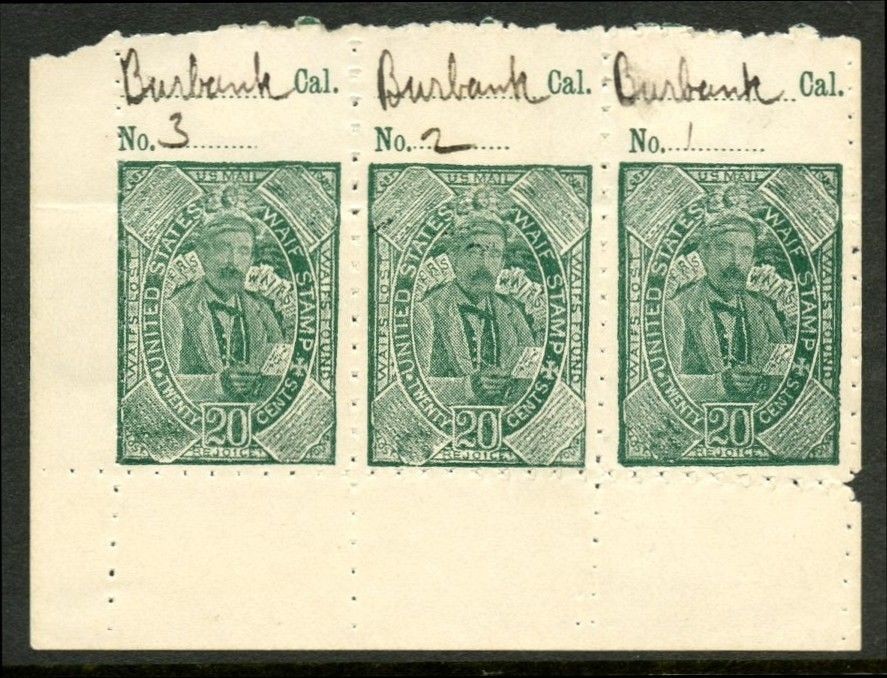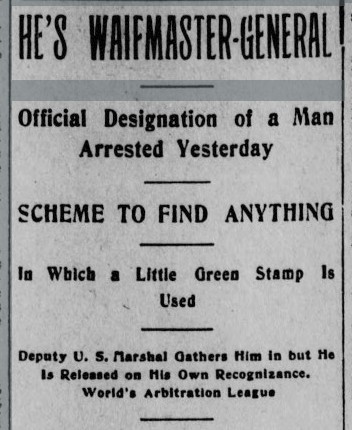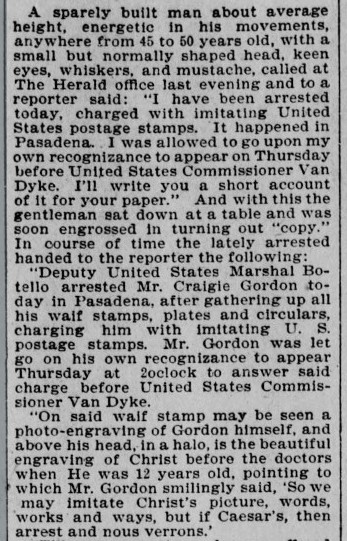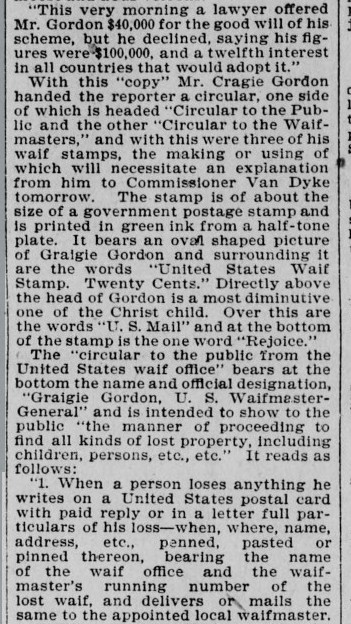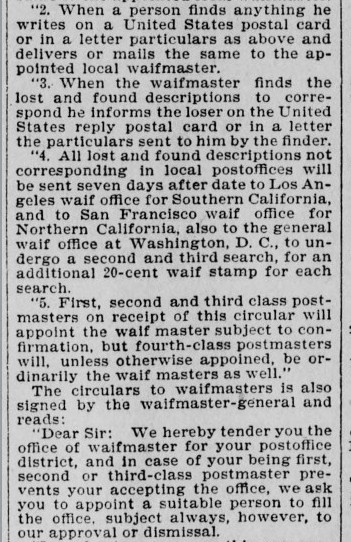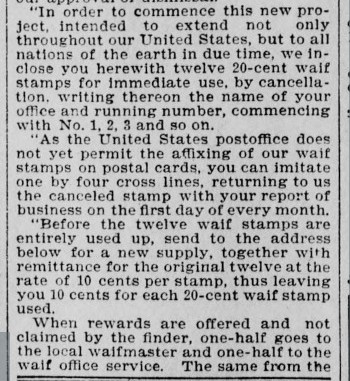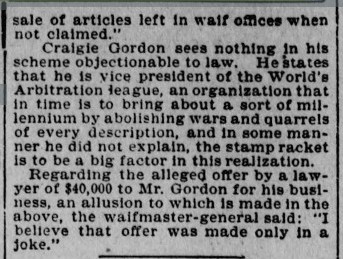|
Los Angeles Herald, Volume 25, Number 252, 10 June 1896
Page 10
HE'S WAIFMASTER-GENERAL
Official Designation of a Man Arrested Yesterday
SCHEME TO FIND ANYTHING
In Which a Little Green Stamp Is Used
Deputy U. S. Marshal Gathers Him In but He is Released on His Own Recognizance.
World's Arbitration League
A sparely built man about average height, energetic in his movements, anywhere
from 45 to 60 years old, with a small but normally shaped head, keen eyes,
whiskers, and mustache, called at The Herald office last evening and to a
reporter said: "I have been arrested today, charged with imitating United States
postage stamps. It happened in Pasadena, I was allowed to go upon my own
recognizance to appear on Thursday before United States Commissioner Van Dyke.
I'll write you a short account of It for your paper." And with this the
gentleman sat down at a table and was soon engrossed In turning out "copy." In
course of time the lately arrested handed to the reporter the following:
"Deputy United States Marshal Botello arrested Mr. Craigie Gordon today in
Pasadena, after gathering up all his waif stamps, plates and circulars, charging
him with imitating U. S. postage stamps. Mr. Gordon was let go on his own
recognizance to appear Thursday at 2oclock to answer said charge before United
States Commissioner Van Dyke.
"On said waif stamp may be seen a photo-engraving of Gordon himself, and above
his head, In a halo, is the beautiful engraving of Christ before the doctors
when He was 12 years old, pointing to which Mr. Gordon smilingly said, 'So we
may imitate Christ's picture, words, works and ways, but if Caesar's, then
arrest and nous verrons.'
"This very morning a lawyer offered Mr. Gordon $40,000 for the good will of his
scheme, but he declined, saying his figures were SIOO,OOO. and a twelfth
interest In all countries that would adopt it."
With this "copy" Mr. Craigie Gordon handed the reporter a circular, one side of
which Is headed "Circular to the Public and the other "Circular to the
Waifmasters," and with this were three of his waif stamps, the making or using
of which will necessitate an explanation from him to Commissioner Van Dyke
tomorrow. The stamp is of about the size of a government postage stamp and Is
printed in green ink from a half-tone plate. It bears an oval shaped picture of
Graigie Gordon and surrounding It are the words "United States Waif Stamp.
Twenty Cents." Directly above the head of Gordon is a most diminutive one of the
Christ child. Over this are the words "U. S. Mail" and at the bottom of the
stamp is the one word "Rejoice."
The "circular to the public from the United States waif office" bears at the
bottom the name and official designation, "Graigie Gordon, U. S.
Waifmaster General" and is intended to show to the public "the manner of
proceeding to find all kinds of lost property, Including children, persons,
etc., etc." It reads as follows:
"1. When a person loses anything he writes on a United States postal card I with
paid reply or in a letter full particulars of his loss-when, where, name,
address, etc., panned, pasted or : pinned thereon, bearing the name of the waif
office and the waifmaster's running number of the lost waif, and delivers
or mails the same to the appointed local waifmaster. "
2. When a person finds anything he writes on a United States postal card or in a
letter particulars as above and delivers or mails the same to the appointed
local waifmaster. "
3. When the waifmaster finds the lost and found descriptions to correspond he
informs the loser on the United States reply postal card or In a letter the
particulars sent to him by the finder. "
4. All lost and found descriptions not corresponding in local post offices will
be sent seven days after date to Los Angeles waif office for Southern
California, and to San Francisco waif office for Northern California, also to
the general waif office at Washington, D. C, to undergo a second and third
search, for an i additional 20-cent waif stamp for each search. "
5. First, second and third class post masters on receipt of this circular will
appoint the waif master subject to confirmation, but fourth-class postmasters
j will, unless otherwise appointed, be ordinarily the waif masters as well."
The circulars to waifmasters is also signed by the waifmaster-general and reads:
"Dear Sir: We hereby tender you the office of waifmaster for your post office
district, and In case of your being first, second or third-class postmaster
prevents your accepting the office, we ask you to appoint a suitable person to
fill the office, subject always, however, to our approval or dismissal.
"In order to commence this new project, Intended to extend not only throughout
our United States, but to all nations of the earth in due time, we enclose you
herewith twelve 20-cent waif stamps for immediate use, by cancellation, writing
thereon the name of your office and running number, commencing with No. 1, 2, 3
and so on.
"As the United States post office does not yet permit the affixing of our wait
stamps on postal cards, you can imitate one by four cross lines, returning to us
the canceled stamp with your report of business on the first day of every
month.
"Before the twelve waif stamps are entirely used up, send to the address below
for a new supply, together with remittance for the original twelve at the rate
of 10 cents per stamp, thus leaving you 10 cents for each 20-cent waif stamp
used.
When rewards are offered and not claimed by the finder, one-half goes to the
local waifmaster and one-half to the waif office service. The same from the sale
of articles left In waif offices when not claimed."
Craigle Gordon sees nothing In his scheme objectionable to law. He states that
he is vice president of the World's Arbitration league, an organization that In
time is to bring about a sort of millennium by abolishing wars and quarrels of
every description, and In some manner he did not explain, the stamp racket Is to
be a big factor in this realization.
Regarding the alleged offer by a lawyer of $40,000 to Mr. Gordon for his
business, an allusion to which Is made In the above, the walfmaster-general
said: "I believe that offer was made only In a joke."
| 